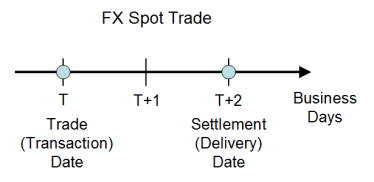One of the essential things that traders need to know to get started is the spot rate. Businesses that invariably deal with foreign currencies also have to stay apprised of the spot rates because of their interaction with countries’ economies. In this article, we go through its definition, its influencers, and compare it with other types of exchange rates.
The Definition of Forex Spot Exchange Rate
The price mark at which you trade one currency for another at this present moment is the simplest definition of the spot exchange rate; or how much you have to pay in one for another currency right now? The delivery or settlement for such transactions takes about two working days after it takes place as this is the earliest value date that one can get.
The value of the rates is governed by the Forex market where various entities, from traders to institutions and even countries, deal and execute transactions. It is the largest market in the world due to its volatility and size made up by these transactions, which amount to about 6 trillion every day.
The market itself can be quite unstable. Rates are impacted by such things as trading, speculations, and the news. But, in the long term, it is the differences in the interest rate and macroeconomic influencers that drive the rates.
Currencies are also kept in check by their governments, particularly those of emerging economies, which set the rate. For instance, the Yen is pegged to the dollar in a tight range. The central banks have to step in sometimes and smoothen the market through buying or selling the home currencies. Those economies that have a large reserve of foreign currencies are in a better position to affect the spot rates of their home currency.
Most of the trading that takes place happens electronically. Many other markets are also a participant in this, which include big corporations and companies, governments, and hedge and mutual funds. These dealings are executed for various reasons, such as investments, and import/export of payments, loans, etc.
One can execute spot exchange in a number of ways, especially nowadays when online trading has become a convenient option. This eliminates the need for the middle-man and it can be done directly between the involved parties. One can also utilize systems that automate order placements.
No single spot rate
A trader or businessman has to know more than one spot rate. For instance, traders can make money on the spread between the ‘bid’ and ‘offer’ rates. But, most of the exchange rates are between these two points. The exact point will also depend on whether you’re striking an offer or a bid rate.
Small traders tend to be price takers while other, larger players have the ability to bargain and even impact the rates through their trading activity alone.
The word ‘spot’ in the context of Forex trade means ‘on the spot.’ Even though most people see it as something right away and this seems right, in the Forex market, it means ‘on the date of the transaction.’ The settlements occur 2 days later and are termed T+2.
There are some pairs that settle early than two days. The USD/CAD is settled a day later, a T+1; Yuan settles on the date of the transaction itself, a T+0. Business days do not include legal holidays, Saturdays, and Sundays.
Forex Spot vs. Forward Exchange
Because contract settlements take place sometime after the trade is agreed upon in both forward and spot exchanges, one could argue that all these settlements are technically forward. But, there are a few pertinent differences between these two.
- The settlement/expiry date
The settlement date for a forward contract is the date on which it expires or ‘matures.’ Either of the parties can exchange funds if the contract is deliverable. But, there is no such expiry date for a spot exchange. It expires as soon as it is struck; the delay in the delivery of funds is only normative.

That is why if the transaction payments are needed immediately, the trader has no other choice but to go for the current spot rate. But, if that is not a requirement, then a trader can trade on either the forward or spot rate and get the delivery at some later date.
- Price/rate
These two types are differently priced as well. For a spot settlement, the rate is just the market rate on that day for a particular currency pair. On the contrary, for a forward contract, the rate is based on a formula that bases its calculations on the difference in interest rates.
- Risk management
But, spot rates have a clear advantage of forward ones; they help to manage risk. Spot settlements lock in the rates for long periods of time. They, therefore, allow one to safeguard against currency fluctuations. This is also colloquially known as currency hedging.
The takeaway
Spot exchange rates determine, ultimately, the price at which you have to sell one currency for another. Traders and businesses have to keep track of the spot rate of currencies, especially if they want their trades settled in a couple of business days.
They also have to be apprised of the macroeconomic influencers as well to know and speculate fluctuations in the rate. This is important for traders as they are usually the ones taking the price, and they should be aware of the spreads that they’re getting and the technical analyses that they can do to minimize it.
The forward rate is quite different from the spot rate mainly due to the time frame of settlements. Traders gravitate towards spot rates because with these they can manage their risks better against a fluctuating market.
